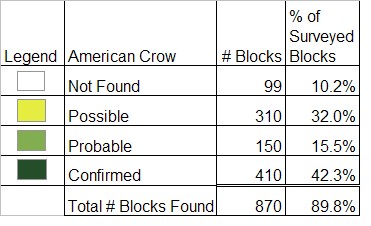Find a Bird - BBA1
Breeding Bird Atlas 1 Species Accounts
American Crow
Corvus brachyrhynchos
Egg Dates
March to June 13
Number of Broods
one; may re-lay if first attempt fails.

The American Crow is one of the most familiar birds in the Commonwealth. It is found in forested areas, in fields and pastures, and along coastal beaches. During the Atlas period, nesting was confirmed in all sections of the state. The high number of confirmations in densely populated areas in eastern Massachusetts is a good indication of the crow’s adaptability. Formerly, the species was held in general disdain and universally persecuted, but today, except during a brief open hunting season, crows are basically regarded with indifference or ignored, despite their occasional forays into cornfields and gardens.
In addition to the familiar caw or cah calls, given singly or in a series, the crow has a number of vocalizations used in different contexts and has the ability to imitate other birds and animals, including the human voice. The American Crow is a common year-round resident and shows a distinct preference for agricultural lands and farms, where food is readily available. Communal winter roosts begin to break up in late February and early March. Courtship behavior includes strutting, posturing, and vigorous, tumbling flights. There are many reports of two- and three-bird groups engaging in bill touching and mutual head and neck preening. Crows may breed in pairs or in cooperative groups, with offspring from previous years remaining to help their parents rear new broods. In a Massachusetts study, breeding group size ranged from 2 to 10 members, with an average of 4.4 birds. Such groups actively defend all-purpose territories averaging 104 acres throughout the year (Chamberlain-Auger).
Nests are constructed of sticks and twigs, generally broken from tree branches rather than selected from the ground litter, and are lined with dead grass. They are usually located in conifers, forested areas, or isolated woodlots, and are well concealed in the crotch of a high, horizontal branch. In Worcester County, nests are generally reported in White Pine (Blodget, TC). Forty-nine nests from Barnstable and Middlesex counties were located as follows: Pitch Pine (42 nests), White Pine (2 nests), spruce (2 nests), Red Cedar (2 nests), willow (1 nest) (Chamberlain-Auger). These nests averaged 16 inches in diameter, and the mean height was 32 feet. New nests are constructed each year, and in some instances a second is built if the first fails (Chamberlain-Auger). During all phases of the breeding cycle, crows are extremely wary and tend to make surreptitious trips to and from their nest.
Eggs are laid as early as March and as late as June (Chamberlain-Auger) but generally are produced in April or early May. The clutch size may vary from three to seven eggs, but the average is four to six. The clutch sizes for 7 Worcester County nests were four eggs (4 nests), five eggs (3 nests) (DKW). Incubation, mostly by the female, averaged 22.3 days for 12 state nests. Both parents feed the young. Nestlings have been reported in the state from April to July. The mean number of days until fledging for 16 Massachusetts nests was 30.1 days (Chamberlain-Auger). As soon as the young can fly, they move from the nest to nearby trees, where they reveal their presence by food-begging calls. Newly fledged young have been recorded in the state from May to August. The average number of fledglings for 49 nesting groups in Barnstable and Middlesex counties was 2.1 birds. Fledglings are fed by the adults for two to four weeks and then sporadically for the next six months to a year (Chamberlain-Auger). As the young mature, they begin foraging in open areas with the adults. Carrion and insects form much of their diet during the summer.
In fall, sizeable flocks of crows are a familiar sight in agricultural areas, where they feed on waste corn and chance animal tidbits. Modern harvesting practices leave substantial waste. The state crow population is apparently less migratory now than it was half a century ago, although birds from farther north may pass through or winter here.
Communal night roosts, which are utilized during fall and winter, begin forming in late August and are well established by late October. Such roosts are usually located in dense stands of White Pine, often on a hillside, and frequently are occupied year after year. In the South and Midwest, such tradi- tional roosts may host hundreds of thou- sands of crows; but in Massachusetts, several thousand individuals is a typical maximum. Birds travel 30 miles or more to forage during the day. In the evening, crows may gather in a staging area located a mile or more from the roost before coordinated movement to the roost is made. When approaching the roost, crows are usually silent; in contrast, when departing in the morning, they are typically noisy and leave for feeding areas in a direct line or “as the crow flies.”
In spite of an adverse reputation and intense persecution in the past, the crow flourishes today, adapting to the radical environmental alterations of humankind. The American Crow is, above all else, a survivor.
Map Legend and Data Summary
Atlas 1 data collected from 1975-1979


Note: common and widespread throughout the state
Richard A. Forster



